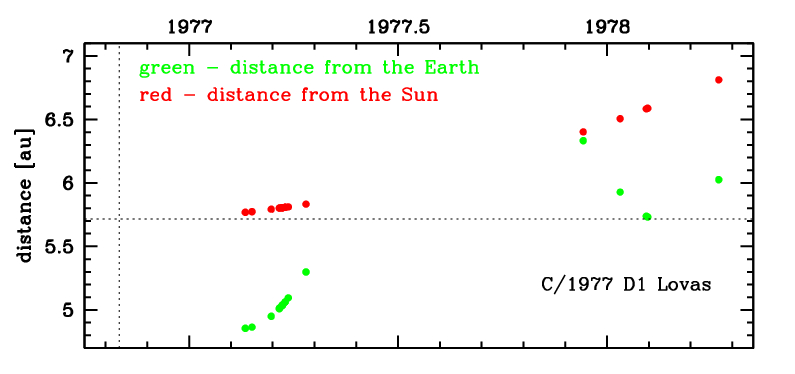C/1977 D1 Lovas
more info
Comet C/1977 D1 was discovered on 17 February 1977, 3.5 months after its perihelion passage, and was last seen on 7 April 1978 [Kronk and Meyer, Cometography: Volume 5].
The comet made its closest approach to the Earth on 15 February 1977 (4.85 au), that was two days before its discovery.
Solution given here is based on data spanning over 1.07 yr in a range of heliocentric distances from 5.77 au to 6.81 au.
This Oort spike comet suffers rather small planetary perturbations during its passage through the planetary system but these perturbations can lead to escape of the comet from the solar system (see original and future orbits).
See also Królikowska and Dybczyński 2017.
The comet made its closest approach to the Earth on 15 February 1977 (4.85 au), that was two days before its discovery.
Solution given here is based on data spanning over 1.07 yr in a range of heliocentric distances from 5.77 au to 6.81 au.
This Oort spike comet suffers rather small planetary perturbations during its passage through the planetary system but these perturbations can lead to escape of the comet from the solar system (see original and future orbits).
See also Królikowska and Dybczyński 2017.
| solution description | ||
|---|---|---|
| number of observations | 17 | |
| data interval | 1977 02 17 – 1978 04 07 | |
| data type | observed only after perihelion (POST) | |
| data arc selection | entire data set (STD) | |
| range of heliocentric distances | 5.77 au – 6.81au | |
| detectability of NG effects in the comet's motion | NG effects not determinable | |
| type of model of motion | GR - gravitational orbit | |
| data weighting | NO | |
| number of residuals | 34 | |
| RMS [arcseconds] | 2.38 | |
| orbit quality class | 1b | |
| previous orbit statistics, both Galactic and stellar perturbations were taken into account | ||
|---|---|---|
| no. of returning VCs in the swarm | 3700 | * |
| no. of escaping VCs in the swarm | 1301 | |
| no. of hyperbolas among escaping VCs in the swarm | 886 | |
| previous reciprocal semi-major axis [10-6 au-1] | -16.90 – 41.60 – 97.74 | |
| previous perihelion distance [au] | 5.9 – 7.8 – 2300 | R |
| previous aphelion distance [103 au] | 20 – 39 – 160 | |
| time interval to previous perihelion [Myr] | 0.93 – 2.4 – 8.1 | R |
| percentage of VCs with qprev < 10 | 52 | |
| percentage of VCs with qprev > 20 | 48 | |
| previous_g orbit statistics, here only the Galactic tide has been included | ||
|---|---|---|
| no. of returning VCs in the swarm | 3571 | * |
| no. of escaping VCs in the swarm | 1430 | |
| no. of hyperbolas among escaping VCs in the swarm | 893 | |
| previous reciprocal semi-major axis [10-6 au-1] | -17.08 – 41.55 – 97.73 | |
| previous perihelion distance [au] | 5.8 – 6.9 – 140 | R |
| previous aphelion distance [103 au] | 20 – 39 – 160 | |
| time interval to previous perihelion [Myr] | 0.91 – 2.2 – 8 | R |
| percentage of VCs with qprev < 10 | 66 | |
| percentage of VCs with 10 < qprev < 20 | 11 | |
| percentage of VCs with qprev > 20 | 23 | |
